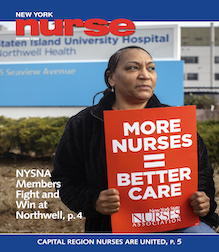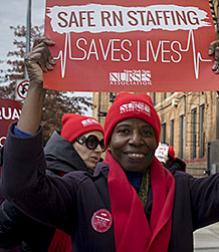New York patients are at risk from unsafe staffing.
We see this as nurses every day. But hospital administrators are trying to stop us from solving the crisis — and they’re spreading misinformation about staffing.
We need to counter those myths with the truth — our patients are counting on us.
I’ve heard many of these myths before. They came up in California, where we won staffing ratios. Here’s what the research — and nurses’ own experience — has to say.
Myth #1: There is no direct link between mandated nurse staffing ratios and improved patient outcomes.
Fact: The number of patients assigned to a nurse has a direct impact on our ability to appropriately assess, monitor, care for, and safely discharge our patients.
Hospitals which routinely staff with 1:8 nurse-to-patient ratios experience five additional deaths per 1,000 patients than those staffing with 1:4 nurse-to-patient ratios (Journal of the American Medical Association, 2002).
Myth #2: Mandated staffing ratios could force hospitals to close or cut services, which could compromise access to care.
Fact: Not one California hospital closed because of ratio implementation. In California, hospital income rose dramatically after ratios were implemented, from $12.5 billion from 1994 to 2003, to more than $20.6 billion from 2004 to 2010 (Institute for Health & Socio-Economic Policy).
Myth #3: Safe staffing ratios would cost New York’s hospitals and nursing homes too much.
Fact: Unsafe staffing hurts the bottom line by increasing rates of costly hospital-acquired infections, patient falls, 30-day readmissions, medical malpractice, nurse burnout and staff turnover, when compared to healthcare facilities that meet safe staffing levels.
Evidence and experience demonstrate that safe staffing is a cost-effective way to improve patient care and can lead to savings for our hospitals, nursing homes and our healthcare system.
In California, hospital income rose dramatically after ratios were implemented, from $12.5 billion from 1994 to 2003, to more than $20.6 billion from 2004 to 2010. Not one California hospital closed because of ratio implementation (Institute for Health and Socio-Economic Policy, 2011).
Myth #4: Hospitals need flexibility in staffing – fixed ratios won’t meet the needs of patients.
Fact: The ratios set a minimum standard based on research evidence, best practices and the experience in California.
Ratios will provide a safe minimum level of staffing. Hospitals and nursing homes will still have flexibility in staffing – but they cannot go below the levels that the research demonstrates are safe.
Myth #5: Hospitals will have to lay off other caregivers if safe staffing ratios are implemented.
Fact: Non-nurse staffing levels at hospitals increased after safe staffing ratios were implemented in California.
The number of total nursing assistive personnel increased by 64% in California hospitals since 2005, after the ratios were implemented. That is a rate 59% higher than the rate of increase of hospital nursing assistive personnel nationally (Institute for Health & Socio-Economic Policy).
These facts are just the tip of the iceberg. You can get even more here.




